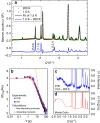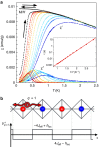Fragmentation in spin ice from magnetic charge injection
- PMID: 28785000
- PMCID: PMC5547148
- DOI: 10.1038/s41467-017-00277-1
Fragmentation in spin ice from magnetic charge injection
Abstract
The complexity embedded in condensed matter fertilizes the discovery of new states of matter, enriched by ingredients like frustration. Illustrating examples in magnetic systems are Kitaev spin liquids, skyrmions phases, or spin ices. These unconventional ground states support exotic excitations, for example the magnetic charges in spin ices, also called monopoles. Here, we propose a mechanism to inject monopoles in a spin ice at equilibrium through a staggered magnetic field. We show theoretically, and demonstrate experimentally in the Ho2Ir2O7 pyrochlore iridate, that it results in the stabilization of a monopole crystal, which exhibits magnetic fragmentation. In this new state of matter, the magnetic moment fragments into an ordered part and a persistently fluctuating one. Compared to conventional spin ices, the different nature of the excitations in this fragmented state opens the way to tunable field-induced and dynamical behaviors.Exploring unconventional magnetism facilities both fundamental understanding of materials and their real applications. Here the authors demonstrate that a magnetic monopole crystal is stabilized by a staggered magnetic field in the pyrochlore iridate Ho2Ir2O7, leading to a fragmented magnetization.
Conflict of interest statement
The authors declare no competing financial interests.
Figures




References
-
- Harris MJ, Bramwell ST, McMorrow DF, Zeiske T, Godfrey KW. Geometrical frustration in the ferromagnetic pyrochlore Ho2Ti2O7. Phys. Rev. Lett. 1997;79:2554–2557. doi: 10.1103/PhysRevLett.79.2554. - DOI
-
- Henley CL. The Coulomb phase in frustrated systems. Ann. Rev. Condens. Matter Phys. 2010;1:179–210. doi: 10.1146/annurev-conmatphys-070909-104138. - DOI
-
- Henley CL. Power-law spin correlations in pyrochlore antiferromagnets. Phys. Rev. B. 2005;71:014424. doi: 10.1103/PhysRevB.71.014424. - DOI
Publication types
LinkOut - more resources
Full Text Sources
Other Literature Sources

